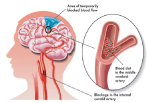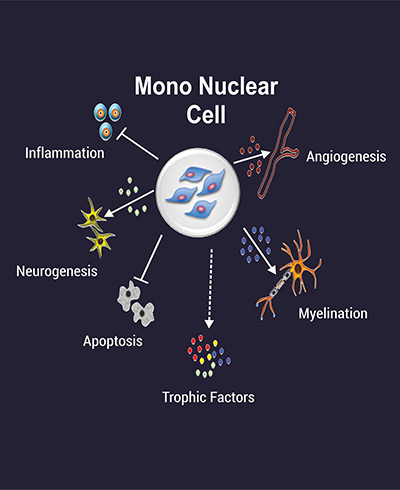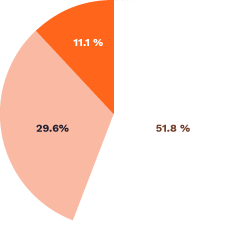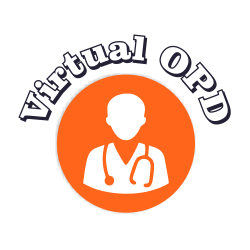Strokes occur because of the blockage of blood supply and blood vessels within the brain. When a person has a stroke, treatment must be immediately sought as it can lead to more serious clinical conditions. If a patient is attended to on time, then it reduces the chances of more complications.
A brain stroke is a medical emergency and the patient should be taken to a hospital as soon as possible to prevent further damage to the brain. Investigations such as Computed Tomography (CT) Scan help in confirming the type of stroke.
Thrombotic Stroke

Embolic Stroke

It is the most commonly occurring cause of stroke. An Ischaemic Stroke occurs due to an interruption of the blood supply is due to a blockage in the blood vessel by a clot or thickening of the artery walls. These blood clots usually form in areas where the arteries have been narrowed or blocked by fatty cholesterol-containing deposits known as plaques.
occurs when a blood clot impairs blood flow in an artery that supplies blood to the brain.
occurs when a blood clot that forms elsewhere in the body (embolus) breaks loose and travels to the brain via the bloodstream. Eventually, the clot lodges in a blood vessel and blocks the flow of blood, causing a stroke.
Cerebral Hemorrhage

A hemorrhagic stroke occurs from a damaged vessel that ruptures and bleeds into the brain. This results in a blood build up which constricts the region of the brain tissue. A hemorrhagic stroke can damage cerebral arteries and result in high blood pressure. In a more serious case, injury can lead to brain bleeding ultimately leading to blood clot formation. There are other risk factors involved like being overweight, smoking, excessive alcohol intake, lack of exercise and stress.

A Transient ischemic attack can occur due to a temporary reduction in the brain blood supply. It is comparable with stroke symptoms and it is known as a mini stroke too. This kind of attack does not leave behind a permanent damage as the blockage is momentary.
Often, various unhealthy habits, which are characteristic of a “bad lifestyle’ can be attributed to increased chances of stroke. Having said this, a stroke could also result as a hereditary predisposition. The greater the risk factors, the higher the chances of a stroke.
High blood pressure
High blood pressure is the highest risk factor for stroke. Blood pressure is considered high if it stays at or above 140/90 mmHg for three consecutive days at the same time, when taken in the same posture. For diabetic or people with chronic kidney disease, high blood pressure is defined as 130/80 mmHg or higher.
Diabetes
Diabetes occurs as a result of abnormal blood sugar levels, due to an imbalanced insulin production. Insulin is a hormone that helps move blood sugar into cells where it’s used for energy. A prolonged imbalance of blood sugar can increase the risk of stroke.
Cardiovascular Disease
Any cardiovascular disorders, such as coronary heart disease, cardiomyopathy, heart failure, and atrial fibrillation can cause blood clots that can lead to a stroke.
Smoking
Smoking damages blood vessels and raises blood pressure, while also reducing the amount of oxygen that reaches your body’s tissues. Exposure to secondhand smoke also can damage the blood vessels.
Age and gender
Age also increases the chances of a stroke. Men are more likely to suffer strokes at younger ages, as compared to women. Fatality by stroke is, however, observed to be higher in women than in men. Women who take birth control pills also are at a slightly higher risk of stroke.
Race and ethnicity
Studies have shown that African American, Alaska Native, and American Indian adults have a higher chance of suffering strokes than in white, Hispanic, or Asian American adults.
Personal or family history of stroke or TIA
A past history of a stroke increases the chances of another stroke. People with strong family history of strokes also have a higher chance of suffering from one too.
A balloon-like bulge of tangled faulty arteries and veins that can rupture, is known as aneurysm. They may be present since birth, but often aren’t diagnosed until they rupture.
The risk factors which can be controlled are:
Alcohol and illegal drug use, including cocaine, amphetamines, and other drugs. Certain medical conditions, such as sickle cell disease, vasculitis (inflammation of the blood vessels), and bleeding disorders, a sedentary lifestyle, obesity, stress and depression, unhealthy cholesterol levels, an unhealthy diet can also be controlled. The excessive use of nonsteroidal anti-inflammatory drugs (NSAIDs), but not aspirin, may also increase the chances of a stroke, particularly in patients who have had a previous cardiac attacks or cardiac bypass surgery.
The best way to avoid a stroke is to maintain a healthy lifestyle.
Maintain your
blood pressure
Lower your
cholesterol
Eat a balanced
and healthy diet
Regularly exercise
Treat sleep apnea
Manage your
blood sugar levels
Avoid or drink
alcohol in moderation
Stop smoking
Avoid Stress
Maintain a
healthy weight

Autologous Bone Marrow Mononuclear Cells Grafting for stroke has increased the hope of the application of mesenchymal cells to repair brain damage. Stroke autologous bone marrow mononuclear cells grafting with animal models of ischemic stroke have shown functional recovery which indicates that mesenchymal bone marrow-derived cells promote repair. Making a distinction with the human mesenchymal bone marrow-derived cells into cells can transfer along the paths that bear a resemblance to neuronal progenitor cells. Additionally, the generation of the mononuclear fraction consists of numerous cells that can emit out cytokines and trophic factors. All these help in generating the supply of blood, neuroprotection and neuroregeneration in areas that are affected in stroke, by autologous bone marrow mononuclear cells grafting.
We are committed and dedicated at bringing improvement in our patients’ quality of life. Many patients that came for treatment had reached a plateau stage regarding the improvements in their symptoms. Our patients have demonstrated incredible improvements after autologous bone marrow mononuclear cells grafting for stroke in India. It helps patients to resume their normal activities and get back to being independent.
Improvements are seen in
Improvements in upper
limb activity/hand functions,
Better lower limb activity
Improved trunk activity
Better balance
Higher mental functions/speech
Better ambulation
Better activities of daily living
STATISTICS OF OVERALL IMPROVEMENTS IN PATIENTS AFTER AUTOLOGOUS BONE MARROW MONONUCLEAR CELLS GRAFTING FOR STROKE IN INDIA, AT NEUROGEN
96% patients have shown overall improvements


The research for patients showed that
Considerable
Moderate
Mild
A stroke can strike at any hour and can occur as a consequence to loss of blood flow to the brain that causes cells to die. It is sometimes known as brain attacks. The damage that cell death causes to the brain increases with time and it is important to seek help right away if someone a stroke strikes someone.
There are two different types of stroke. One is ischemic stroke and the other is hemorrhagic stroke. An ischemic stroke is caused due to the blockage of an artery or blood vessel. About 80% of strokes are ischemic. The other 20% forms the hemorrhagic strokes and it takes place when the blood vessel or artery splits and leaks into the brain.
The common risk factors for a stroke are uncontrolled high blood pressure, constant smoking, obesity or being overweight, poor dietary habits, sedentary lifestyle or physical inactivity, chronic uncontrolled diabetes, high cholesterol and triglyceride levels.
There are certain symptoms of a stroke that one needs to look out. Signs like sudden numbness or weakness of face, arm, or leg on one side of the body, sudden confusion, trouble speaking or understanding, sudden difficulty seeing or loss of vision, sudden trouble walking, dizziness, or imbalance. There could also be unexpected unconsciousness connected with it.
The extent of recovery that can be achieved after the stroke are varied. A stroke does harm to the brain cells. The degree of brain damage and the size of the stroke are directly connected to the extent of the impairments or paralysis. People suffering a minor stroke may have only slight impairments such as a weak arm or leg. However a massive stroke can cause a person to lose the ability to read, write, or speak. It may also result in paralysis.
Treatments are specified depending on the type and severity of the stroke. For example, if the patient has suffered an ischemic stroke, then an immediate therapy must be given to him. On the other hand, if the patient suffers a hemorrhagic stroke, immediate therapies that include medication and surgery is given to him
Rehabilitation is a significant aspect of stroke care. At NeuroGen, the patients are provided the most comprehensive and holistic stroke rehabilitation. Our rehabilitation program includes speech therapy, physical therapy, and occupational therapy.
Stroke autologous bone marrow mononuclear cells grafting restores the brain damage which is giving less performance after suffering from a brain stroke. autologous bone marrow mononuclear cells grafting for stroke works well with the rehabilitation process. The combination of autologous bone marrow mononuclear cells grafting for Stroke with vigorous neurorehabilitation helps to speed up the recovery process.
The biological task of bone marrow-derived cells is to repair and regenerate damaged cells. autologous bone marrow mononuclear cells grafting for Stroke exploits this function by administering these cells in high concentrations directly in and around the damaged tissue, where they advance its self healing and repair.
No, there are no ethical concerns surrounding adult stem cell research and therapy. Ethical concerns are mostly occurs through the use of embryonic cells. Our cell treatment for stroke consists of using cells which are taken out from the patient’s own body and it is free from ethical concerns
No, Autologous Bone Marrow Mononuclear Cells Grafting for Stroke is not painful as the therapy is done under local anesthesia and mild sedation. There is no major pain or discomfort during or after the procedure.
The whole session of autologous bone marrow mononuclear cells grafting for stroke is safe and till date none of our patients have shown any signs of neurological deterioration. In rare cases, side effects like headache for 3-4 days, neck or back pain, vomiting, mild rash or pain at the area of bone marrow aspirations may arise. Some unexpected medical complications can occur but that is just a possibility.
This may vary from patient to patient. Some patients makes a speedy improvement by 3-6 months of autologous bone marrow mononuclear cells grafting for Stroke while in some cases patients take several months or years together to heal. And there are some patients that recover even before their discharge
This will depend on the condition of the patient. If the patient shows signs of improvement after the first procedure then a second transplantation may be suggested by a team of experts. The second transplantation can transpire anytime between 3-6 months of the first therapy of stroke autologous bone marrow mononuclear cells grafting.
We will have to review the entire dose of medication before coming upon a decision. Generally we do allow the patients to continue their other medication. But it is better to consult a doctor beforehand
Since autologous bone marrow mononuclear cells grafting for stroke is a new therapy and not an existing one, it is difficult to say. It will depend on several factors like the age of patient, type of illness, duration of illness and extent of rehabilitation taken after the treatment.
